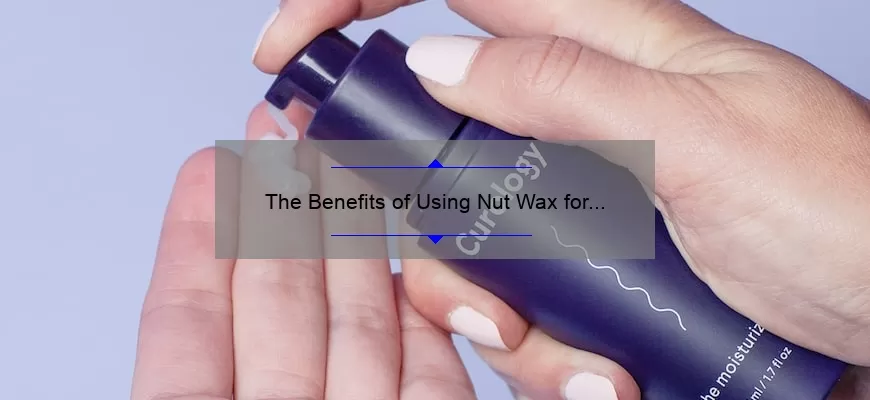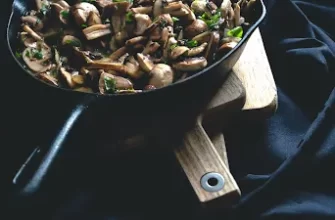What is Nut Wax and How to Make Your Own
Nut wax is a type of natural wax made from the oil pressed from nuts. It has been used for centuries by various cultures around the world, especially in Asia and Africa, to create waterproof fabrics, as sealants and adhesives, and even on its own as a natural skincare product. Nut wax has also been used in cosmetics to provide shine and softness to lips, eyebrows, hair care products and more.
The nut wax is created when raw nut oils are heated until their triglycerides break down into much smaller molecules which form a solid waxy skin at room temperature. This natural wax can be collected by filtering out the solid material during the heating process or by scraping it off once the oil cools completely.
Making your own nut wax at home is relatively easy and inexpensive. All you need is some raw nut oil (such as almond or coconut oil), a pot with a lid that fits securely, an oven mitt/glove or other protective covering for your hand, and optionally a few sheets of paper towel for covering the bottom of your pot if desired.
To begin, preheat your oven to the lowest possible setting before pouring enough of your chosen nut oil in to cover the bottom of your pot about one quarter inch deep; now secure its lid tightly onto it before putting it inside your preheated oven for 3-4 hours until all water content has fully evaporated. Once this occurs remove the pot carefully with an oven mitt/glove (as it will be very hot!) and set aside on a heat-resistant surface; allowing it to cool completely over several hours while stirring occasionally during this time will yield an even thicker wax after removal. Once solidified you can scrape away any excess with a butter knife or similar utensil – but note that depending upon how much you’ve cooked down may require multiple layers of scraped away material before desired results are achieved!
In sum: Nut Wax is an all-natural product made by heating raw nut oils until their triglycerides break down into small molecules forming a solid waxy substance at room temperature; making this product yourself is easily manageable using basic kitchen equipment such as an oven safe pan/pot & lid with low heat settings attained through preheating – then simply leave it in said device for 3-4 hours per quarter inch directed layer – stirring intermittently throughout – until desired outcomes have been reached!
Step by Step Guide to Making Nut Wax at Home
Making nut wax at home is a surprisingly simple process that can be done with only a few basic supplies and some knowledge about the materials used.
1. Gather your materials: You’ll need raw nuts of your desired type, such as walnuts or pecans, a double boiler (or a pot and heat safe bowl that fits snugly inside it), some stirring sticks, cheesecloth, and optionally essential oils for fragrance.
2. Roast the nuts: Place your chosen nuts in an oven-safe dish and roast for about 15 minutes in a preheated 375 degree oven until lightly browned but not burned. Allow to cool completely before proceeding further with the steps below.
3. Add your roasted nuts to the double boiler: Using either glass or ceramic containers (depending on what you have on hand), add them to one half of the double boiler along with enough water to fill the bottom half up slowly.? The goal is to slowly melt down the oils from inside the raw nuts into liquid form to be added later on in step three. Keep an eye out for any burning or sticking that might occur too quickly here – adjust heat levels if necessary!
4. Strain out any impurities: Once all of your oil has been melted down, use a cheesecloth placed over an appropriately sized strainer positioned just above another bowl or pot to strain out any leftover particles or fibres from your liquid wax mixture.? This will make sure that when you come back around to using this liquid wax later on in steps five and six it will be free of anything else lurking within!
5. Reheat & stir Wax mixture: With most of your unwanted particles strained away, you can now stick everything back onto a stove top burner set at low-medium heat.? Stir occasionally while keeping watch; you don’t want any part of this liquid wax mixture burning or simmering too long because that would affect its overall purity/quality before being ready for use!? By gently ‘warming’ things up again here we will bring our melted oils back together with helpful beeswax which should’ve solidified by now from being left outside during cooling phases earlier in step two (this helps us achieve just the right consistency for our desired nut waxy product).
6. Add fragrances & aromas (optional): For niche uses like candles or lip balms where smell and scent are key factors adding essential oils or other naturally derived fragrances can help give products a unique twist! Make sure they get properly blended during heating processes by continually stirring them into mixtures until absolutely blended throughly though – remember temperature fluctuations also affect ingredients potency so take care when dealing with these powerful natural substances.? Generally speaking anything volatile/pungent should always be dealt with extra caution; meaning more common scents like lavender/rosemary ought not require too much additional poweurs?just depending ?on quality intensities available :D.
7. Remove from heat & pour away!: Now isn’t time go let things cool off yet – instead remove items still sitting atop stoves immediately when finished heating&mixings!! Take note how hot wax could potentially crystallize upon sudden temperature changes so if possible try running warm water over outsides container first before pouring away its contents into designated vessels/molds already prepared earlier in prep period.. all finished! _ Congrats — You’ve now created homemade nutwax enrichments suitable for various DIY projects 😉 Enjoy^^
Necessary Tools and Ingredients Needed to Make Nut Wax
Making your own nut wax can be both a fun and cost-effective approach to personal care. All you need are the right tools and ingredients, which you may already have in your kitchen pantry. Here’s a look at the necessary supplies you’ll need to get started:
Tools
The most important tool for making your own nut wax is an electric mixer or double boiler. An electric mixer ensures that all of the ingredients are thoroughly mixed together so as not to leave any clumps behind, while a double boiler allows for gentle heating of the mixture. If you don’t have an electric mixer or double boiler, you can use a spoon or whisk to mix and heat the ingredients until they reach the desired consistency. In addition, you’ll also need clear plastic molds for pouring and shaping your wax into bars.
Ingredients
Nut wax is generally made with inexpensive butems such as beeswax, coconut oil and shea butter – although other oils, such as almond oil or jojoba oil can be used if desired. These items can typically be purchased in bulk at health food stores as well as craft stores like Michaels and Hobby Lobby; however, some people choose to purchase these items online from trusted retailers such as Amazon or Etsy. Furthermore, it’s important to use pure essential oils when concocting your own nut wax – fragranced oils will yield an inconsistent finish with each batch made since their viscosity can differ greatly from one product to another.
By gathering all of these necessary tools and ingredients ahead of time – you can ensure that you have everything on hand when it comes time to start creating your very own homemade nut wax!
FAQs About the Process of Making Nut Wax
Q: What is nut wax?
A: Nut wax is a type of plant-based wax made through the process of combining ground nuts and vegetable oils. It is often used as an alternative to beeswax, which has a much higher melting point and is not vegan-friendly. Nut wax can be used to create body balms, lip balms, lotions, salves and polishes.
Q: How is nut wax made?
A: The process of creating nut wax begins by collecting ground nuts—such as almond meal or hazelnuts—and/or nut oils (such as coconut oil or macadamia oil). Once collected, the ingredient mix can then be combined together with vegetable oils such as olive oil and then heated to low temperatures until it has reached the desired consistency and texture. After this step, the mixture is left to cool before it can be scooped out and packaged for use in body products.
Q: Are there any benefits of using nut wax over other types of waxes?
A: Yes! Compared to beeswax, nut-based plant-waxes are generally equal in terms of stability but provide a softer texture than when using beeswax alone. They also work nicely when blended with other buttery or liquid ingredients; this makes them ideal for body care applications like creams, moisturizers and salves. Additionally, they’re vegan-friendly!
Q: Are there any drawbacks to using nut wax?
A: As with all beauty ingredients there are potential drawbacks that should be taken into consideration before making your selection; these include cost (nut-based plant waxy tend to cost more than some alternatives), availability (not all areas have access to sources that supply these products) and shelf life (since they contain oils they may expire sooner than some other products). Additionally, they do have a relatively high melting point so if you’re looking for something that will hold up in warmer climates when being used outdoors then you may want to look at other options instead.
Top 5 Safety Tips for Working with Nut Wax
Safety is of paramount importance for everyone working with nut wax. The following five tips will help ensure that everyone is safe when handling this material.
1. Know the process: It’s essential that anyone involved in the production of a food or body-care product containing nut wax understands the manufacturing and/or finishing process, including how to properly handle and prepare the ingredients prior to using them. This includes safety precautions, like wearing eye protection and gloves, as well as following all safety guidelines established by your company or industry regulator.
2. Use Proper Protection: Because nut wax can produce fumes that are harmful to breathing, it’s essential to use proper protection when handling the material. Wearing face masks, gloves, and protective clothing is important for safeguarding against contact with skin and eyes. Additionally, ensure adequate ventilation in the work area at all times to reduce any potential risk posed by inhaling potential fumes from nut wax being heated or processed during production.
3. Store Safely: Nut wax should be stored away from direct heat sources such as ovens or cooktops in well-ventilated areas so that any spills don’t lead to an inhalation hazard while cleaning up afterwards. Also remember to mark containers clearly if you’re storing multiple varieties of melting point materials onsite so workers know these containers contain different substances which can react differently if exposed to hot temperatures upon opening and stirring them up together accidentally. Don’t forget to include instructions regarding their intended uses and other safety protocols associated with each specific type of nut wax too!
4. Measure Accurately: To achieve consistent results within your product’s formula, it’s important you measure out exactly what is needed without rounding up or guessing about amounts required for certain recipes -fumes are dangerous both when airborne but also when over measured quantities get melted together in batches resulting in much higher levels released than expected over short periods near areas where personnel may be unwarily standing closeby .If performing a physical task like stirring complicated formulas take regular breaks from it every 10 minutes – 30 seconds works best -to avoid overexerting yourself prematurely due spoilage caused by mixing environments being presented with excessive heat not initially anticipated further weakening mixes before time runs out causing wastage expenses generated otherwise avoided altogether had periodic recall checks been conducted each time rather than waiting till complete container allocations were attained putting added unnecessary pressure upon personnel working within those particular contexts etc…
5 Practice Good Habits & Clean Up: Workers should practice good habits in order stay safe while handling nut wax ingredients such as never licking spoons or utensils they came into contact with while stirring mixtures -ease-of-practice rules apply here; also make sure surfaces are cleaned often after every day’s ended operations (wiping down table tops especially) – double check they haven’t been exposed excessively unto elevated heats through faulty wiring setup structures etc… Like finger smudges left on cold surfaces which can easily turn warm when environmental conditions worsen leading onto messier sustained situations behind desks where potentially hazardous aerosol creature of nourishments have been let loose untreated due inadequate maintenance observations routines not followed accurately at required points throughout duty shifts recently undertaken overall encouraging good behaviour whenever applicable helps assess smaller details more profusely immediately turning forgotten findings into productive advancement experiences many occasions much earlier on…
Examples of Finished Projects Using Homemade Nut Wax
Homemade nut wax is an inexpensive, natural alternative to traditional chemical-based waxes used in furniture making and woodworking. While it has gained increasing popularity as a safe, non-toxic finish for many types of projects, it can also be used to add unique flair to numerous projects at the same time. In this blog post we’ll show you some real-world examples of projects using homemade nut wax.
The first example is a custom cutting board utilized by a professional chef for culinary demonstrations. After a light scraping and thorough cleaning with mineral spirits to remove older finishes, the mahogany board was treated with two coats of homemade walnut wax. The result? A beautiful food-safe finish that will provide years of service! This is just one small example of how DIY nut wax can help define your project’s aesthetic and give it an added level of protection too!
Another neat use for homemade wax is its ability to enhance plain woodwork such as tool chests and boxes. For instance, one craftsperson created a stylish vintage jewelry box out of solid teak utilizing their own formula (beeswax + linseed oil + mineral spirits). The finished product had glossy accents around the edges which made the deep red tones on the wood stand out much more than if they’d opted against applying any sort of fine wood finishing product altogether!
Last but certainly not least–using homemade nut wax can also achieve various effects when used on pianos or other musical instruments. One sound technician refinished an old upright piano using walnut oil followed by their own formulation of three parts beeswax, four parts carnauba wax, and seven parts jojoba oil–all heated together until fully melted then applied in thin coats with fine steel wool between each layer. When completed this gave the instrument a subtle glistening patina that beautifully complimented its original art deco works on the outer casing while providing excellent protection from dings or scratches!
These are just a few examples that demonstrate what kind outcomes you can expect when utilizing simple (but effective) DIY techniques involving homemade nut oils and waxes on all sorts of wooden items in your workshop or home studio. Whether you’re crafting furniture, creating custom cutting boards for your kitchen or giving some new life to an old piano–this unique technique could very well change up your working style even moreso than ever before!



![Unlocking the Mystery of Black Gorilla Lug Nuts: A Story of Strength and Style [5 Essential Tips for Choosing the Best Lug Nuts]](https://baru-nuts.com/wp-content/uploads/2023/04/21-335x220.jpg)
![Rev Up Your Ride: The Ultimate Guide to Black Chrome Lug Nuts [Solve Your Wheel Woes with Expert Tips and Stats]](https://baru-nuts.com/wp-content/uploads/2023/04/22-335x220.webp)
![Binky Goes Nuts: A Tale of a Mischievous Pet and How to Keep Them Calm [Expert Tips and Stats]](https://baru-nuts.com/wp-content/uploads/2023/04/23-335x220.jpg)


